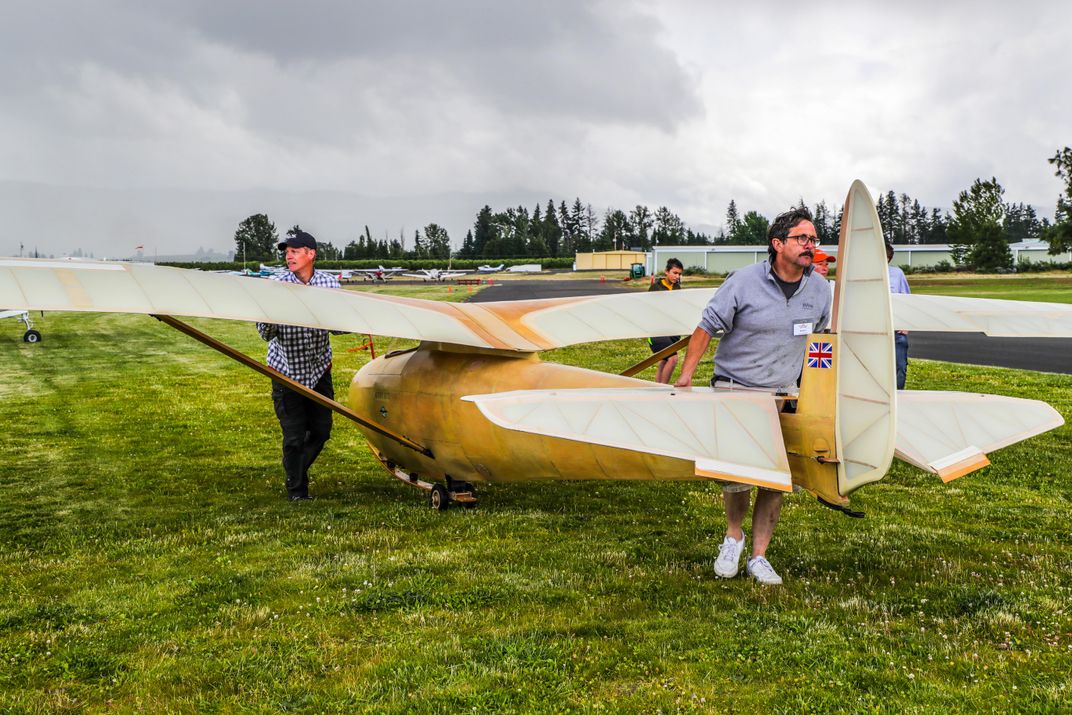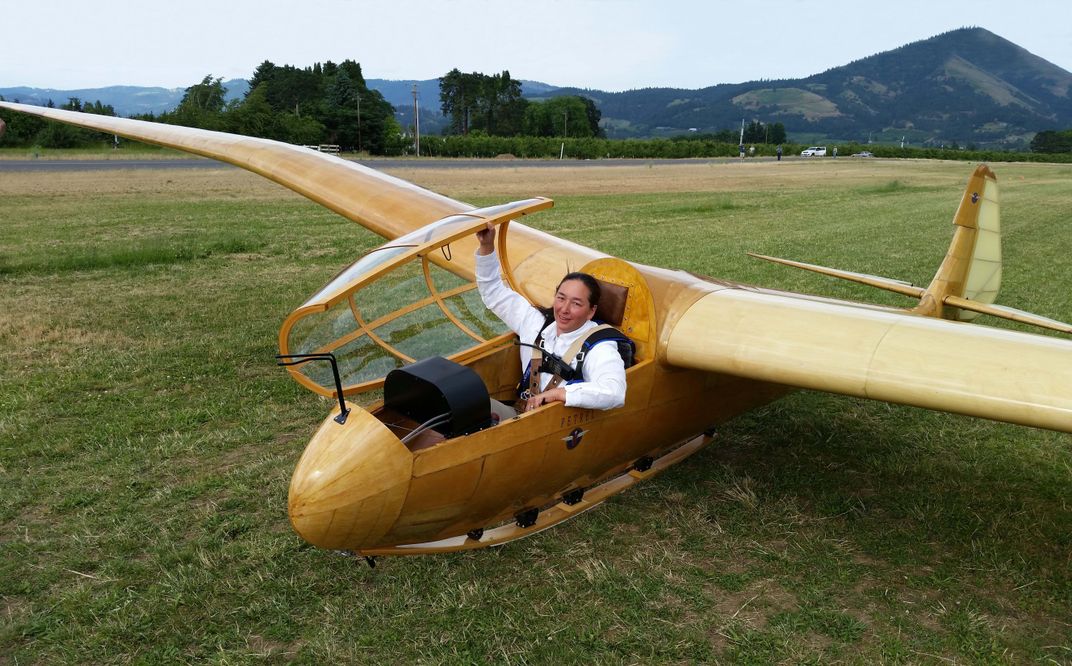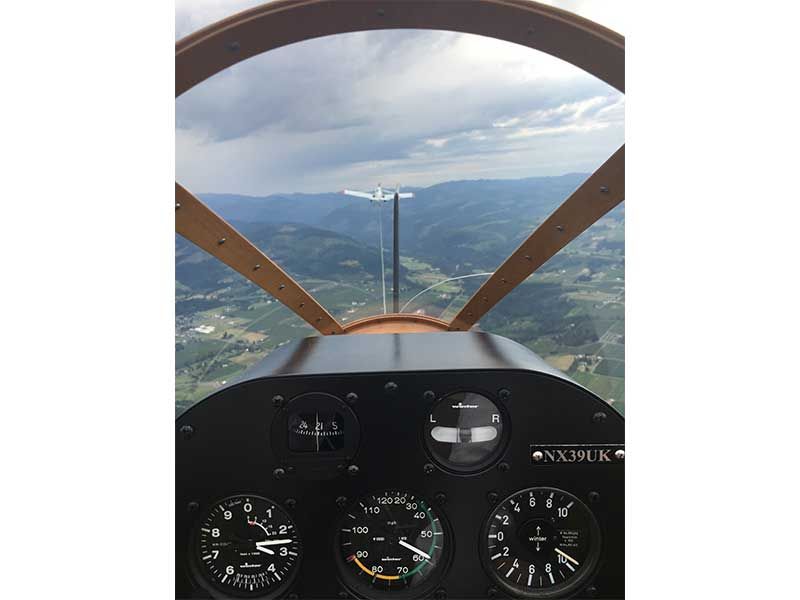A Petrel’s Strange Journey
Why a rare British sailplane survived.
In 1937, up on the windy heights of the Yorkshire moors, British sportsman Frank Charles taught himself to fly in primitive gliders. He soon tired of their limited capabilities, and went in search of something that could actually soar instead of simply glide downhill. The best sailplanes of the day were being designed and built in Germany, so Charles asked a local firm, Slingsby Sailplanes Limited, to build an airplane based on German designs.
Between-the-wars British airplane manufacturers—de Havilland, Percival, Miles—had developed wood aircraft construction into a high art, and Slingsby continued the tradition by producing a beautifully proportioned wood glider. The long, tapered gull wings, the slender fuselage, even the canopy frame and landing skid were fashioned of bent and molded birch plywood. In the air, the expansive wings and translucent fabric covering reminded everyone of a bird, so Charles chose the name “Petrel” for his new mount, after the handsome seabird. The first Petrel flew in 1938, and by 1939 three had been constructed.
Two of the sailplanes flew in a British gliding competition in July 1939. The results were mixed and tragic. Charles died in the original Petrel when a winch cable failed to release, pulling him into the ground. However, the second example, BGA418—the first “production” Petrel—finished fourth in the contest, a performance that seemed to hold great promise. Volume production was under consideration, but World War II began and civil aircraft manufacturing was no longer a priority. The design was never put back into production, so the three Petrels completed by Slingsby were the only ones ever built.
After the war, a small syndicate of enthusiasts found BGA418 stuffed away in the back of a hangar in Shropshire, England. They bought it and flew it for some years, repairing the wood structure as necessary and, for some reason, covering the varnished birch with a coat of white paint.
In 2002, the “White Petrel” (the other, still flying in the United Kingdom, is known as the “Red Petrel”) came to the attention of American Robert Gaines. Although he had made his living flying airliners, Gaines had a passion for soaring, particularly in vintage gliders. He already owned several sailplanes, but he was captured by the Petrel’s beauty. Gaines bought it. Intending to return it to its original splendor, he brought it back to the United States and stripped the white paint and fabric down to bare wood, but never got much further.
Gaines died in 2011, and another sailplane enthusiast, Jerry Wenger, stepped in. A successful businessman, Wenger had pursued competitive soaring and found himself drawn to the historical roots of the sport. He purchased Gaines’ entire collection of vintage gliders and donated them to the Western Antique Aeroplane & Automobile Museum in Hood River, Oregon. (The donation included another type of Slingsby glider, the Kirby Kite, some of which were used by the Royal Air Force as trainers during World War II.) Because the museum has a tradition of flying the aircraft in its collection, it would be necessary to complete the restoration of the Petrel.
The museum handed the task to Tom Evelo in Powell, Wyoming. Evelo, a rangy Westerner who would look completely at home on a horse in the high mountains, combines the practical skills of a ranch kid with the aesthetic delicacy of a violin maker. He is not a pilot; instead, he has an artist’s appreciation for the aerodynamic form of rare vintage gliders. “At first, it looked like we could just do a final sand and varnish and start re-covering, but a trial assembly killed that dream,” says Evelo. “The tail bearings didn’t line up, and we found rot in the wing spars and inboard ribs.”
To get to the spars, Evelo had to remove the leading edge of the wing. On a metal airplane, this is relatively easy: Drill out the rivets and take off the skin. On the Petrel, the molded wood leading edge is glued to the wing ribs and to the spar itself. The only way to remove it is to saw out the wood between the ribs and sand away the remnants of skin still attached to the skeletal structure. “It takes a steady hand,” says Evelo. “If you’re careful, you can see the glue line appear as the skin turns into sawdust, and [you] won’t damage the rib underneath.”
When the wing and tail repairs were finished, Evelo turned to the most difficult part of the project—the nose. “The original nose-cone was made from strips of wood, but somewhere along the line, a metal version had been fitted,” he says. “I made a form, then soaked and steamed plywood strips until they were flexible enough to conform to it. [Molding] plywood that’s less than one-eighth-inch thick and bent in a tight curve is not easy,” says Evelo. “It took six months to get it right.”
When the restored Petrel was returned to the Western Antique Aeroplane & Automobile Museum, the staff needed a pilot familiar with the ways of vintage gliders, so they turned to Marici Reid, who first soloed in a glider at 16. She had logged many hours in modern sailplanes, but her first chance to fly some of the old ones came when she was in England on business in 2000. She had a couple of free days and used them to attend a Vintage Sailplane Association meet.
“Strange situation,” she remembers. “There was a Japanese contingent there, with a couple of antique Japanese gliders. None of them spoke English, so there was a lot of confusion. I was raised speaking Japanese, and I knew gliders, so I was in the right spot at the right time. As a result, I got to fly several rare old airplanes, and I was hooked.”
Reid took the Petrel for its first post-restoration flight on a blustery day in June 2017. “Tom Evelo’s craftsmanship was apparent everywhere,” she says. “The controls were absolutely precise, and the canopy fit so well there was virtually no wind noise. It was a joy to fly—light and responsive and perfectly balanced. When I landed, Tom was the first person to meet me, and he wanted to know: How did it fly? For a minute or two, I couldn’t answer him—I couldn’t find words. The whole experience was just so beautiful.”
The Petrel spent the winter stationed at the museum’s indoor display, but last fall, it flew again, cruising over the Columbia River. The White Petrel, no longer white, is a long way from Yorkshire in both time and distance, but it’s still at home—in the air.
/https://tf-cmsv2-smithsonianmag-media.s3.amazonaws.com/filer/f5/a0/f5a08544-14d1-4072-8588-a61b65c971d6/09g_dj2019_jansmawaaamgliders006_live-web.jpg)



